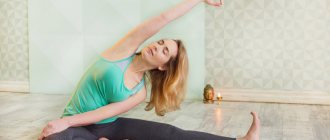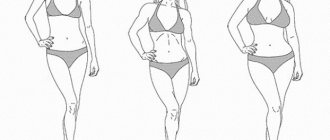How is yoga beneficial for women's health?
Women's yoga brings harmony to health and allows you to get rid of difficulties of various kinds. This happens by performing practical exercises that act on all three levels of the endocrine system - the hypothalamus, pituitary gland and ovaries. With the coordinated interaction of these levels, hormonal and biochemical processes proceed correctly.
What does women's practice provide and why is it needed:
- formation of correct posture, normalization of metabolism, getting rid of extra pounds;
- increasing muscle elasticity and flexibility if you do asanas such as Parshvottanasana, Adho Mukha Svanasana, Virasana, Virabhadrasana 1 and others on a regular basis;
- strengthening the immune system , increasing the protective barrier of the female body to common diseases;
- the skin is cleansed, becomes elastic, toned, tightened, the appearance of swelling and wrinkles is prevented;
- strengthening blood vessels , normalizing blood pressure, reducing blood viscosity, which reduces the risk of stroke;
- normalization of the hormonal system (including increased appetite goes away);
- improvement of blood circulation , blood supply with oxygen; cleansing cells of toxins, improving brain activity (an exercise with your head upside down, for example, Shashankasana, is suitable for this);
- the processes of rejuvenation of the body are launched;
- weakening of pain syndromes during menstruation and the premenstrual period;
- improved sleep , easy adaptation to stressful situations, relief from depression and anxiety.
Yoga has a powerful effect on the body, which becomes noticeable after just a month of regular practice.
What is aerial yoga
Aerial yoga is often called Antigravity or aerial yoga.
Such names are attached to the direction due to its specificity (all manipulations are performed in a hanging hammock). A swing with loops for arms and legs is attached directly to the ceiling. The canvas is made of durable nylon fabric that can withstand up to 180 kg of live weight. The height increases gradually from 30-50 cm to 1 m. There is always a safety net below. Aeroyoga combines straight and inverted elements of acrobatics, callanetics, yoga, stretching, and Pilates. It sounds difficult, but in fact, training is accessible even to people with zero level of training. Antigravity differs significantly from other types of fitness in terms of the level of novelty of emotions.
Aeroyoga slows down the aging process (cells are renewed with a vengeance, nutrients activate the long-term production of collagen and elastin).
The main feature of the direction lies in physics. The hammock takes on some of the human weight. The body puts much less pressure on the body, performing asanas, turns, and stretching becomes much easier. It is easier for joints to move, muscles relax from tension, and return to natural flexibility.
What do classes provide on the mental and spiritual levels?
Calming breathing practices (Nadi Shodhana, Apanasati, etc.), relaxation techniques (meditation, Yoga Nidra, Shavasana) have a positive effect on a woman’s psychological health.
Women's psychology is a particularly sensitive area due to mood swings, emotional outbursts, and intense sensitivity. Yoga helps women explore their true nature and purpose, understand their real needs, learn to express them with dignity, without being influenced by external circumstances. A woman gains confidence in her strength, becomes optimistic, charismatic, and attractive.
Yoga, with the right and regular approach, begins to bring more and more pleasure from practice. It is not like a grueling workout, and therefore any woman can enjoy it.
What is good practice for the fair half of humanity? The spiritual component receives a powerful boost, and when a woman is metaphysically ready, a charge of personal development occurs with inevitable changes in the quality of life.
The benefits of yoga for women
Yoga is a practice to restore and maintain a person’s spiritual, mental and physical integrity. In this article we will look at the positive aspects of the influence of yoga on women of all ages, and also present several of the most effective asanas for women.
The influence of yoga on women under 25 years of age
As you know, yoga helps people of all ages, but how exactly is it useful for women in the “under 25 years” category?
Motherhood;
The practice of yoga keeps the body in balance, which undoubtedly has a positive effect on the reproductive system, preparing the body for pregnancy and childbirth without any complications.
Nervous system;
Regular yoga classes balance the body, sensitivity and awareness of the body appear, which helps young women not to overexert themselves and to understand themselves better.
Body quality;
Performing asanas develops flexibility and mobility, and also strengthens various muscle groups and has a combined effect on the body as a whole.
Memory, mental abilities.
At the beginning of the article, we already noted that yoga helps not only physical, but also mental health. During practice, the psyche is “unloaded”, the mood becomes even, and cheerfulness appears. Thanks to inner peace, the mind is less susceptible to stress, memory improves and mental abilities develop.
In addition to the above points, it is worth paying attention to the fact that the practice of yoga also affects a woman’s appearance. The complexion remains bright, the body is less susceptible to aging. If you take care of your body and psyche from an early age and improve yourself, your future life will be calm and harmonious.
The influence of yoga on women after 35 years
As you know, with age, your health reserves begin to dry up, and therefore you should take more intensive care of your quality of life. Yoga will be an excellent support for your mental and physical health. In addition to the points stated above, for women after (and in some cases before) 35 years of age, yoga will help in the following areas:
- Balancing the psyche;
- Restoring the diet;
Thanks to a better understanding of your body, it will become easier to control your diet, which will have a positive effect on your weight.
- Healthy body tone;
- Strengthening immunity;
- Improving metabolism;
The physical activity that yoga provides is involved in the complex healing of the body, improving metabolism.
- Reduced fatigue and irritation;
The production of various hormones and the performance of asanas that help in establishing calm have a positive effect on a woman’s mental state. Understanding of yourself and your body comes, the mind becomes stable, as a result of which the level of fatigue and irritation decreases.
- Increased sexual activity of women.
The influence of yoga on women after 50 years
With increasing life expectancy, women aged 50 are still the fair sex with a vibrant and rich life. At this stage, it is necessary to slow down the aging process and improve physical activity, which yoga does well.
- Preservation of muscle mass, strengthening bones;
Due to hormonal changes, the skeleton of an adult woman becomes more porous and fragile, therefore, to maintain health, as doctors note, the most effective way is to build muscle mass and maintain it. Yoga will certainly help here; it is not as traumatic as some sports, but its impact is often superior to other activities.
- Preservation of the cardiovascular system;
- Nutrition adjustments;
- Maintaining healthy sleep;
The practice of yoga calms the body and reduces its susceptibility to stress. Sleep becomes healthier and deeper, and the body restores the production of the sleep hormone - melatonin.
- Increased life expectancy.
Beneficial yoga poses for women of all ages.
It is worth saying that here are the most popular and useful yoga poses for women. Do not forget that yoga classes should be comprehensive and contain as many different practices as possible.
Vrikshasana - tree pose improves posture, coordination of movements, strengthens the muscles of the legs and back, eliminates flat feet.
Uthitta Trikonasana - elongated triangle pose stimulates intestinal motility, improves skin condition, strengthens the abdominal and back muscles, and creates a thin waist.
Baddha Konasana - bound angle pose, butterfly - stimulates blood circulation, strengthens the uterus and bladder, tones the kidneys.
Upavista Konasana - sitting angle pose improves blood circulation, regulates the menstrual cycle, increases the elasticity of the hip joints, muscles, thighs.
Marjariasana - cat pose, working out the spine, flexibility and fit of the figure, training the abdominal muscles.
Balasana - child's pose relieves tension in the neck, back and leg muscles, improves digestive function.
Shavasana is a pose of complete rest, restoring strength, reducing stress, slowing down the aging process, helping with insomnia and depression.
Back to list
Harm and contraindications
If all the principles of performing asanas are incorrectly or insufficiently understood, a woman can harm her health, for example, stretch muscles, ligaments, damage joints, injure the spine and other undesirable consequences. If there are contraindications, you should definitely consult your doctor and receive appropriate recommendations.
Under no circumstances should you practice practical yoga under the following circumstances:
Legendary meditation course without payment We recommend! The most popular meditation course for beginners in Russian. More than 100 thousand people have already learned to meditate. Try it yourself. Read more.
- mental disorders;
- severe blood and heart diseases;
- the presence of low-quality tumors;
- spinal injuries, traumatic brain injuries;
- hypertension (stage 2 or 3);
You should temporarily limit yourself in activities when a woman:
- increased body temperature;
- painful symptoms or heavy discharge during menstruation;
- first trimester of pregnancy;
- heaviness in the stomach from overeating, full stomach;
- chronic diseases during exacerbation;
- period after surgery.
Set up your inner compass
Once upon a time, many years ago, I gave up meat. Not because it is so accepted and so correct. But because my body itself refused it. At that time, I rarely used it, but the last time my body stopped digesting it, I lay there with aching pain in my side and thoughts - if the body itself doesn’t want to, then that means I’m really ready to become a vegetarian.
And it was very easy and joyful. I had no cravings or memories of the smell and taste of meat products. So many years passed on fruits and vegetables. But in recent months I felt so hungry that I decided not to torture myself during that already difficult period for me.
Yes, I always follow my inner compass. And this helps me make decisions with a light heart and without fear of the consequences of decisions made in this way. Some people call it intuition. Someone makes a decision with their heart. But for some, these are just stories and an unreliable guide. I write about how you can easily and quickly develop intuition here (opens in a new tab).
But for me, my intuition is my main filter for everything that happens in my universe. And when I was faced with the task of how to build my yoga practice in new living conditions, it was my intuition that told me the solution, the result of which I want to share with you.
Tips and exercises for beginners
Before you start practicing, you need to choose comfortable clothes and a suitable yoga mat, according to your preferences and external characteristics. It is recommended to choose a high-quality lightweight mat with anti-slip properties.
The following exercises are useful for women to perform, and, moreover, they are suitable for beginners:
- Janu Sirsasana (head to knee pose);
- Vrikshasana (tree pose);
- BaddhaKonasana or butterfly pose;
- Virabhadrasana - hero pose;
- UpavisthaKonasana – sitting bend with feet wide apart;
- Halasana or plow pose;
- Marjariasana – stretching cat pose;
- Sarvangasana - shoulder stand or birch;
- Paschimottanasana – bending towards the legs while sitting;
- Matsiasana or fish pose;
- Shavasana - relaxation in the dead body pose;
- Yoga mudra is a pose of mental unity.
Very important! You can start exercising only after warming up to warm up your body.
How to start doing yoga?
Before deciding which yoga is suitable for women in a particular case, we recommend that you first consult with our teachers. It might make sense to come to one class. This will allow you to understand in practice how the “training” proceeds and how suitable the teacher leading the class is for you.
If you have health problems, it would be a good idea to visit our diagnostic room, where a specialist will conduct an examination and, based on its results, suggest the optimal types of yoga.
Remember, in order to get results that satisfy you, it is advisable to maintain consistency in your training. Since yoga affects internal processes and restores the functions of systems and organs naturally, this will take time. Therefore, we recommend planning your visit to classes in advance and also purchasing a subscription. According to it, discounts on yoga can be up to 60% of the base cost of one visit.
Eight limbs of yoga
The ancient treatise “Yoga Sutras of Patanjali” describes 8 stages of teaching that a person has to learn:
- Pit. Ethical and moral foundations.
- Niyama. Self-discipline and asceticism.
- Asana. Physical exercise.
- Pranayama. Breathing techniques.
- Pratyahara. Practice controlling your own feelings.
- Dharana. Deep concentration on a specific object.
- Dhyana. Meditation, which is a continuation of Dharana, involves calming the mind.
- Samadhi. Deep meditation that leads to a special state of consciousness. The bonds of the human ego weaken, the internal microcosm merges with the external “cosmic Absolute”.
Modern practitioners do not dive so deeply; they limit themselves to proper breathing, asanas and control over emotions.
A little history
The homeland of the destination is colorful India. The widespread art of peace and self-control was previously something only a select few could do: Buddhists and wealthy men. Women had limited rights in this regard - even rich Indian ladies had access to a limited list of exercises.
Interesting fact. More than 400 interesting poses taken by yogis were depicted on the walls of ancient Indian temples. But for reasons unknown to us, these poses were misunderstood, and as a result, the famous Kama Sutra appeared.
The ancient teaching, which has existed for more than 5,000 years, became widespread worldwide relatively recently, two centuries ago. The fact is that yoga was carefully preserved and was banned for other countries. Today art (that’s what it’s called in its homeland) is accessible to everyone, and India welcomes tourists who want to join the great secrets of yoga.
What harm can you do to yourself through yoga?
As a gymnastics, yoga can be quite extreme, especially when separated from breathing exercises and exercises for mind control and relaxation. If you look at the pictures showing what poses are taken in yoga classes by “experienced” people, it becomes obvious that trying to repeat this is easy to get injured. The most common are muscle and ligament sprains (for example, some people damage the Achilles tendons by overdoing an asana such as “downward-facing dog pose”), joint damage, and various spinal injuries. Extreme attempts to turn the head can injure the vertebral arteries, leading to the formation of blood clots or compression of the arteries, with subsequent brain damage.
When we talk about the harm that classes bring, this applies both to those who do difficult poses without proper preparation, and to those who decide that they are already quite experienced and excessively increase the load, striving to achieve maximum results.
A common mistake is also the incorrect use of pranayama . Intense breathing exercises, as well as deep breath holds, can create an imbalance in the nervous system. Which leads to nervous disorders or loss of concentration, inability to concentrate. The conclusion is quite simple: improperly organized classes cause harm.
Medical view
In Soviet and early post-Soviet times, official medicine did not accept yoga and called the teaching charlatan. Today, many doctors themselves have joined the practice and advise it to patients, especially those for whom other physical activities are contraindicated. The practice is officially used in many health institutions as an activity to strengthen and maintain health. But doctors do not attribute any miraculous properties to yoga and never recommend it as a treatment option.
Let's sum it up
- Yoga is an ideal practice for self-improvement, which is suitable for people of all ages, even those suffering from serious illnesses with contraindications for classical sports.
- During classes, a person does not overexert himself either physically or psychologically.
- There is no need for special conditions for training - all exercises can be done at home, but after preliminary training. Finding a master in small towns is quite difficult, but you can also join the philosophy of life on the Internet: there are many resources and online training to help beginners.
- The positive effect is noticeable after the first lesson.
- Many exercises are available to pregnant women and young mothers.
- People who have started yoga never give up the practice - it is a part of life that helps them stay healthy, happy and successful.
- Statistics results: people who devote 1.5-2 hours a week to practice live 8 years longer than others.
As for the opinion of inveterate skeptics who consider practicing yogis to be eccentric people who “feed on air” and, with their abstraction from the worldly, simply close themselves off from everyday problems - this is an established stereotype that has absolutely no basis. You will be surprised, but most major businessmen, executives, directors and producers have been practicing yoga for many years and owe much of their success to constant practice. A person who practices yoga is less susceptible to stressful situations, makes balanced, reasonable decisions, is able to tune out the little things and focus on what is truly important. Plus, good physical shape, good health and energy. All together creates a real guarantee of success in any business.
Yoga is a deep system of self-improvement - focusing on the present, which gives harmony in the future. The philosophy of the practice wisely says that you need to accept any choice. We in no way impose this direction and do not put it above any sport, but we advise you to consider it to improve your health.
Author:
Sabuk Tatyana Leonidovna hygienist, epidemiologist
Hatha yoga is a universal direction that is suitable for beginners
This is far from a new direction, the history of which goes back 1000 years. Translated, “hatha” means effort, tension, intensity, and yoga is unity. To achieve this very unity will require some effort. It is based on the body taking certain static poses or positions, which can be simple and natural or complex, unusual for the body. The direction does not require strict vegetarianism.
The emphasis is on body development:
- static poses are useful for strengthening the spine, joints, improving the functioning of internal organs and self-education;
- breathing exercises are used to normalize metabolism and improve emotional well-being. Proper breathing enhances the healing effect, helps to quickly achieve progress, relieve discomfort during deep stretches, invigorate at the beginning of classes and relax at the end;
- concentration exercises - to increase composure and improve vision;
- proper nutrition. You should eat a couple of hours before practice;
- meditation is aimed at spiritual enlightenment, but there is not much emphasis placed on it.
Classes begin with a warm-up and intensive breathing with short delays; during the exercises, breathing should be calm, without interruptions. The basis of Hatka yoga is dynamic asana complexes and holding static poses.
- Smooth breathing is important when performing balance asanas and strength exercises - the tissues receive the proper amount of oxygen and improve the body’s adaptation to stress.
- When performing stretching asanas, calm breathing with full inhalations and long exhalations reduces pain.
- Exercises with bending and twisting are performed while inhaling when the body is collected.
- Relaxing asanas and bends are recommended to be performed while exhaling. When performing shivasana, which involves maximum relaxation of the body, breathing slows down gradually, with involuntary delays, but without discomfort.
A few words about nutrition, which is very important for a real yogi: life-giving energy comes with food, and prana comes with water. The main thing is not to overeat, only as much as the body can absorb and only when you feel hungry. It is also important to maintain a rhythm, and not only in food. The body begins to secrete digestive enzymes at a certain time, at which time the gastrointestinal tract is activated and ready to accept food. Chewing food is a special philosophy: the more thoroughly the food is chewed, the less it will be needed to fill you up and the easier it is for the digestive system to digest it.
The priority is vegetarian food, and even more so – non-heat-treated food: fruits, vegetables, bran and grain bread, milk, nuts, honey. Most yogis are quite satisfied with the listed products. If it is difficult to switch to complete vegetarianism, you should reduce the amount of food consumed and fried, salted, smoked, and preserved foods. Meat can be eaten 2-3 times a week, boiled or steamed.
Types and styles of yoga
In addition to the steps and practical techniques, yoga has several types and directions:
- Karma yoga. It implies compliance with all requirements, but taking into account abilities and skills. The main task is non-attachment to the fruits of one’s own actions. Even if they bring good, but are committed for selfish purposes, this is considered as slavery that keeps a person in his world.
- Bhakti yoga. Cultivating devotion and love for God, offering all actions and thoughts to higher matter.
- Jnana yoga. The practice of self-knowledge, the main goal of which is to eliminate ignorance by cultivating the mind in various ways (knowledge, introspection, meditation).
- Raja yoga or classical yoga. Aimed at curbing the mind through various asanas, pranayamas and meditations.
It is not recommended to focus on any one direction; it is better to apply all methods in parallel.
In the 20th century, yoga began to be popularized all over the world: many styles and directions appeared, of which there are more than 40. The most popular of them:
- Ashtanga Vinyasa. Dynamic practice with asanas, between which connecting exercises with breath control are performed. During classes, the emphasis is on energy locks - bandhas, concentration of attention on an area of space or body. Gradually, different levels of difficulty of asanas are learned.
- Iyengar yoga. Gradual learning of each asana, starting from simple and moving to complex. During classes, auxiliary elements are used: pillows, straps, bolsters. A large amount of time is devoted to each exercise.
- Yogalates. Combines yoga and Pilates and is suitable for people with different levels of physical fitness. Includes exercises and meditations. During classes, strength develops, flexibility and stretching improve.
- Yin yoga. A set of exercises designed taking into account the female body. Almost all exercises are performed at a slow pace, allowing you to relax the body as much as possible.
- Aero yoga. A modern trend that requires special devices - long elastic bands with fastenings. Dynamic activities that require good physical endurance. Opens the respiratory centers, promotes the development of flexibility and stretching of the body.
- Hatha yoga. The most popular and widespread direction available to beginners, which we will talk about in more detail.











